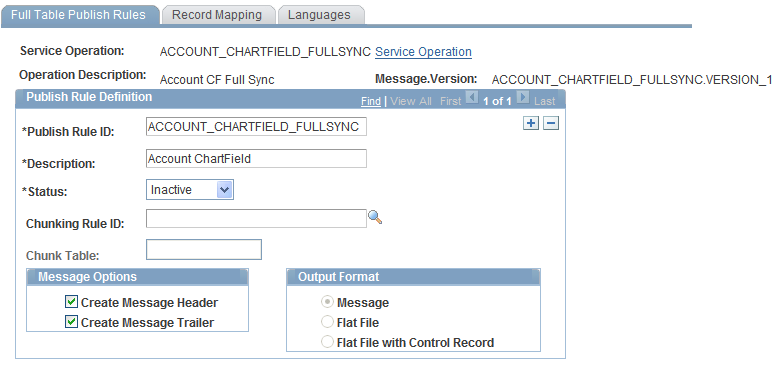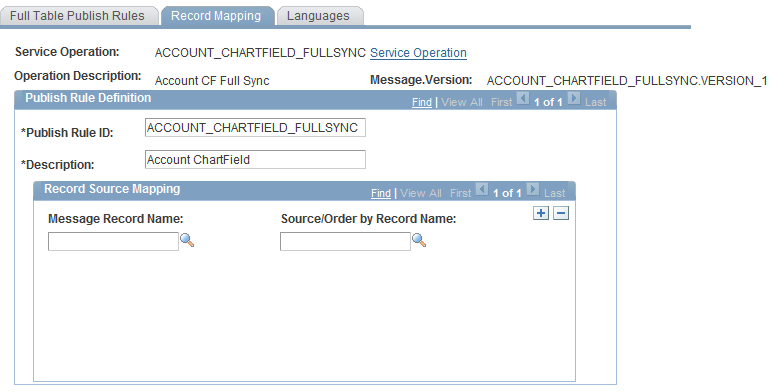Assigning Full Table Publishing Rules
All PeopleSoft applications use common, centralized tables and pages to define how to publish full table messages. The Publish utility uses publishing rules to process the data.
This section discusses how to:
Associate full table publishing rules with messages.
Map a full table message record to another record.
Specify languages in which to publish messages.
Note: You can create multiple publish rules for the same message. The Full Table Publish utility treats each publish rule as a separate publishing cycle.
Pages Used to Assign Full Table Publishing Rules
|
Page Name |
Definition Name |
Navigation |
Usage |
|---|---|---|---|
|
Full Table Publish Rules |
EOIU_SOPUBFULL |
|
Associate a rule with a message and characterize the rule. |
|
Record Mapping |
EOIU_SORECMAP |
|
Map a message record to another record. |
|
Languages |
EOIU_SOLANGUAGE |
|
Specify languages in which to publish a message. |
Full Table Publish Rules Page
Use the Full Table Publish Rules page (EOIU_SOPUBFULL) to associate a rule with a message and characterize the rule.
Image: Full Table Publish Rules page
This example illustrates the fields and controls on the Full Table Publish Rules page. You can find definitions for the fields and controls later on this page.

Use this page to associate a rule to a message and characterize the rule.
Record Mapping Page
Use the Record Mapping page (EOIU_SORECMAP) to map a message record to another record.
Image: Record Mapping page
This example illustrates the fields and controls on the Record Mapping page. You can find definitions for the fields and controls later on this page.

Use this page to map a message record to another record.
Regardless of which source table you use (staging table, temporary table, or a view), ensure that the source table field names are identical to the field names in the target message record. Key fields must also adhere to the parent and child relationship. (Keys of a parent record must exist in the child record, in the same sequence.) The Publish utility uses the Source/Order By Record Name field to select rows for publishing. You use key matching to find all child rows of a parent.
The chunk field should be the primary key field in all Source/Order By records. If the chunk field is not a key field of the level zero record, join the chunk field to all records in which the chunk field does not exist by using views in PeopleSoft Application Designer.
Enter only those message records with a different source or ordering record. If the message record name and the source or ordering record name are identical, do not insert a row for that record on the Record Mapping page.
Languages Page
Use the Languages page (EOIU_SOLANGUAGE) to specify languages in which to publish a message.
Image: Languages page
This example illustrates the fields and controls on the Languages page. You can find definitions for the fields and controls later on this page.

Use this page to specify languages in which to publish a message.